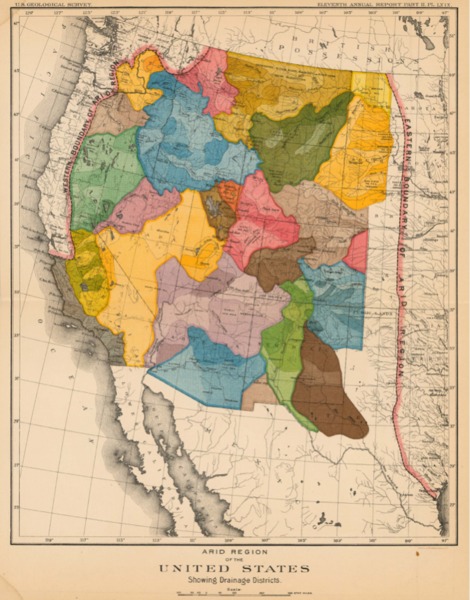Dublin Core
Title
Description
Maps shape how we see our world. Perhaps no one knew this as well as John Wesley Powell, a late-19th Century scientist who was one of the first to survey the American West. Powell’s famous expeditions through America’s canyons and rivers helped create the U.S. Geological Survey in 1879. As director, he created a nationwide topographic mapping project that is still used by federal agencies today. Despite his clear expertise about the land, Powell’s greatest proposal for the American West was rejected.
The 1862 Homestead Act provided 160 acres of land to Americans wanting to settle the frontier, but land west of the 100th Meridian is significantly more arid than in the East. Powell knew there would be problems with access to irrigable land. He proposed that the West be settled within natural watershed boundaries to maximize the use of rainfall as it collected in mountains and ran downstream. Central to his vision was his hydrographic map where the square borders of Utah, Colorado, Arizona, and Nevada were broken up into a vibrant jigsaw puzzle of proposed watershed districts.
When he presented his colorful map to Congress in 1890, Powell hoped to convince them that these districts provided the best way to avoid conflict over water ownership. He envisioned a society where catchment basins were protected by the government to ensure every drop was used and millions of farmers could thrive as a result. Powell’s colorful watershed district map also gives a new way of seeing the West – not by its natural topographic features or arbitrary political borders – but through the waterways that naturally shape it.
Powell’s map confronted U.S. Senators with a truth they refused to admit: that the West was simply too dry to sustainably uphold the economic interests of exploitative developers. With some Senators serving those businesses, many outright rejected Powell’s ideas about water. As years of legal disputes and droughts plague the West, is time proving that Powell was right?
Creator
Source
Image: This map was created by John Wesley Powell in 1890 to represent his ideal settlement pattern for the West, organized by water districts rather than arbitrary state lines. Three years after his watershed districts were rejected, Powell told the International Irrigation Congress “gentlemen, you are piling up a heritage of conflict and litigation over water rights, for there is not sufficient water to supply these lands.” Shouts and boos nearly sent him off the stage. Map of the Arid Region of the United States Showing Drainage Districts, John Wesley Powell, 1890-1891. U.S. Geological Survey.
_______________See Robert Glennon “John Wesley Powell, Great Explorer of the American West,” Scientific American, last modified June 26, 2019; John F. Ross, “The Visionary John Wesley Powell Had a Plan for Developing the West, But Nobody Listened,” Smithsonian Magazine, last modified July 3, 2018; “John Wesley Powell: Biography,” US Geological Survey, accessed January 2021.

